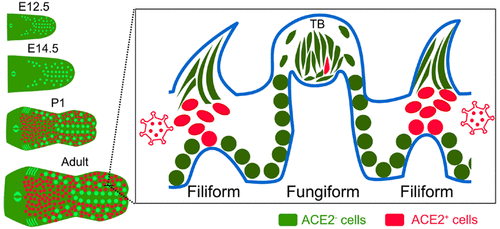当前位置:
X-MOL 学术
›
ACS Pharmacol. Transl. Sci.
›
论文详情
Our official English website, www.x-mol.net, welcomes your
feedback! (Note: you will need to create a separate account there.)
SARS-CoV-2 Receptor ACE2 Is Enriched in a Subpopulation of Mouse Tongue Epithelial Cells in Nongustatory Papillae but Not in Taste Buds or Embryonic Oral Epithelium.
ACS Pharmacology & Translational Science ( IF 4.9 ) Pub Date : 2020-07-23 , DOI: 10.1021/acsptsci.0c00062 Zhonghou Wang 1, 2 , Jingqi Zhou 3 , Brett Marshall 1, 2 , Romdhane Rekaya 2, 4 , Kaixiong Ye 3, 4 , Hong-Xiang Liu 1, 2
ACS Pharmacology & Translational Science ( IF 4.9 ) Pub Date : 2020-07-23 , DOI: 10.1021/acsptsci.0c00062 Zhonghou Wang 1, 2 , Jingqi Zhou 3 , Brett Marshall 1, 2 , Romdhane Rekaya 2, 4 , Kaixiong Ye 3, 4 , Hong-Xiang Liu 1, 2
Affiliation

|
As a result of the COVID-19 pandemic, evidence revealed that SARS-CoV-2 infection caused taste loss at a rate higher than that of influenza. ACE2, the entry receptor of SARS-CoV-2, has been identified in the oral epithelium; however, it is unclear at what developmental stage ACE2 expression emerges and whether ACE2 is expressed in taste buds. To identify the specific developmental stage, we analyzed RNA-Seq data from embryonic and newborn mouse oral tissue. We found that robust ACE2 expression was observed in the newborn oral epithelium. In contrast, only extremely low levels, if any, of ACE2 transcripts in the embryonic stage oral tissue were found (E12.5 and E14.5). Analyses of three public scRNA-seq data sets of adult mouse tongue epithelial cells showed that receptors for various viruses were enriched in distinct clusters of tongue epithelial cells. ACE2 was enriched in a subpopulation of epithelial cells in the basal region of nongustatory filiform papillae but not in the taste papillae or taste buds. Expression of ACE2 was detected in a small proportion of type III taste cells. Our results indicate that when applied across species, nongustatory papilla epithelial cells are the prime targets for SARS-CoV-2 infection in the tongue; thus, taste loss in COVID-19 patients is likely not caused by a direct infection of SARS-CoV-2 to taste bud cells. Additionally, fetuses at different stages of development may have distinct susceptibility to SARS-CoV-2 infection.
中文翻译:

SARS-CoV-2 受体 ACE2 在非味觉乳头的小鼠舌上皮细胞亚群中富集,但在味蕾或胚胎口腔上皮中不富集。
由于 COVID-19 大流行,有证据表明 SARS-CoV-2 感染导致味觉丧失的速度高于流感。ACE2 是 SARS-CoV-2 的进入受体,已在口腔上皮细胞中被发现;然而,尚不清楚ACE2在哪个发育阶段出现表达以及ACE2是否在味蕾中表达。为了确定特定的发育阶段,我们分析了胚胎和新生小鼠口腔组织的 RNA-Seq 数据。我们发现在新生儿口腔上皮中观察到强烈的ACE2表达。相比之下,在胚胎期口腔组织中仅发现极低水平的ACE2转录本(如果有的话)(E12.5 和 E14.5)。对成年小鼠舌上皮细胞的三个公共 scRNA-seq 数据集的分析表明,各种病毒的受体在不同的舌上皮细胞簇中富集。ACE2在非味觉丝状乳头基底区域的上皮细胞亚群中富集,但在味觉乳头或味蕾中不富集。在一小部分 III 型味觉细胞中检测到ACE2的表达。我们的结果表明,当跨物种应用时,非味觉乳头上皮细胞是舌头中 SARS-CoV-2 感染的主要目标;因此,COVID-19 患者的味觉丧失可能不是由 SARS-CoV-2 直接感染味蕾细胞引起的。此外,处于不同发育阶段的胎儿可能对 SARS-CoV-2 感染具有不同的易感性。
更新日期:2020-08-14
中文翻译:

SARS-CoV-2 受体 ACE2 在非味觉乳头的小鼠舌上皮细胞亚群中富集,但在味蕾或胚胎口腔上皮中不富集。
由于 COVID-19 大流行,有证据表明 SARS-CoV-2 感染导致味觉丧失的速度高于流感。ACE2 是 SARS-CoV-2 的进入受体,已在口腔上皮细胞中被发现;然而,尚不清楚ACE2在哪个发育阶段出现表达以及ACE2是否在味蕾中表达。为了确定特定的发育阶段,我们分析了胚胎和新生小鼠口腔组织的 RNA-Seq 数据。我们发现在新生儿口腔上皮中观察到强烈的ACE2表达。相比之下,在胚胎期口腔组织中仅发现极低水平的ACE2转录本(如果有的话)(E12.5 和 E14.5)。对成年小鼠舌上皮细胞的三个公共 scRNA-seq 数据集的分析表明,各种病毒的受体在不同的舌上皮细胞簇中富集。ACE2在非味觉丝状乳头基底区域的上皮细胞亚群中富集,但在味觉乳头或味蕾中不富集。在一小部分 III 型味觉细胞中检测到ACE2的表达。我们的结果表明,当跨物种应用时,非味觉乳头上皮细胞是舌头中 SARS-CoV-2 感染的主要目标;因此,COVID-19 患者的味觉丧失可能不是由 SARS-CoV-2 直接感染味蕾细胞引起的。此外,处于不同发育阶段的胎儿可能对 SARS-CoV-2 感染具有不同的易感性。











































 京公网安备 11010802027423号
京公网安备 11010802027423号